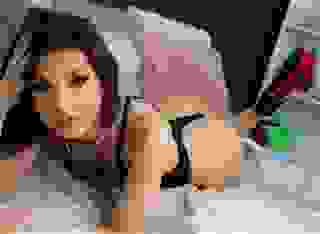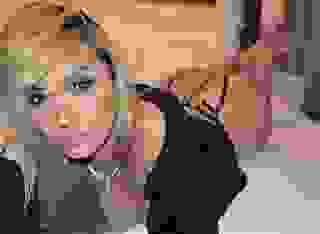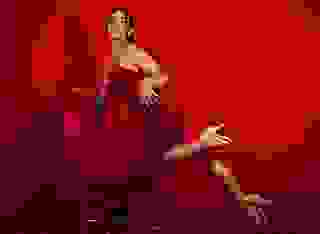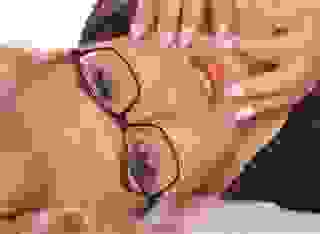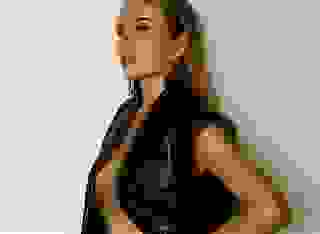Note: You can change font size, font face, and turn on dark mode by clicking the "A" icon tab in the Story Info Box.
You can temporarily switch back to a Classic Literotica® experience during our ongoing public Beta testing. Please consider leaving feedback on issues you experience or suggest improvements.
Click hereShe tapped a few more keys and then muttered "dammit, they didn't", and then turned back to me.
"Do you know about what time they started filming? The date and time start at all zeros so they didn't set the camera clock first."
I said they started about six thirty. Rita typed some more and then the image on the screen changed.
"This should be about seven. What am I looking for?"
I explained what had happened and then showed her the autopsy photo of Mr. Anderson. Rita said "Ugh", and asked if I had an idea where Mr. Anderson was standing. I had the pictures the crime scene techs took that morning, and spread them out on her table.
"He was found here, and there's no evidence he was moved after he was shot."
Rita looked at the picture and then back at her screen. She moved the cursor with her mouse.
"Well, first, lets find him in the video. See these trees in the background? They look like the trees in the pictures. Let me draw some lines on the pictures and then draw the same lines on the video."
It was pretty amazing. Rita drew two lines from two trees to the point where Mr. Edwards was found, measured the angle and then paused the video and drew the same lines from the trees to the battlefield. She pointed to where they crossed.
"I think it's about here. I'll leave my lines on the screen and keep playing the video so we can see if anything happens there."
At seven twenty-three, the man at the intersection of the two lines fell down on his back. Rita used her mouse to zoom in on the man, paused the video, and then looked at me and grinned.
"To me, he looks like your picture. Do you think it's your guy?"
I was used to looking at surveillance camera video and most surveillance camera video isn't that great. You can tell what color the person is and what they're wearing, but if you zoom in for more detail, the picture gets pretty grainy. The picture of Mr. Anderson looked like I was standing right over him.
"Yes, I think that's him. Keep playing the video and see if he does anything."
Mr. Anderson was obviously still alive because he kept moving, but it was also obvious he wasn't acting. About four seconds after he fell down he started to cough and I saw blood running down his cheek.
He was still moving when the bulk of the extras ran past him as they chased after the fleeing opposing forces, and he was still moving, albeit slowly, when the video stopped.
I asked Rita if she could go back to just before Mr. Anderson fell down. The tapped a few keys and when the video started playing, there was Mr. Anderson on the front line of troops running with his rifle. The only person close to him on a horse was a man in a Union Army officer's uniform and I couldn't see his face. I asked Rita if she could print that frame of video and then load another disk and find the same time frame.
After three disks, Rita found one shot from ground level facing the oncoming Union Troops. When she got to the frame that showed both Mr. Anderson and the man on the horse, I recognized the man because I'd already met him. He was Mr. Nelson, the Commander of Mr. Anderson's re-enactment group. He had drawn a revolver and was pointing it in the direction he was riding.
I asked Rita if she could go frame to frame up until the time Mr. Anderson fell down. She clicked one key and the frame changed.
I watched as she went through that process over and over. Mr. Nelson occasionally jerked his hand like the revolver had fired, but there was no smoke coming out of the barrel. Just before Mr. Anderson fell down though, Mr. Nelson dropped his right hand, the hand holding the revolver, until it was pointed down and to his side. In the next frame, there was a cloud of smoke that covered Mr. Anderson's head. I couldn't tell for sure if it came from Mr. Nelson's revolver or from a close rifle, but it looked like it could have come from the revolver and Mr. Nelson was in the right position to have shot Mr. Anderson. In the next frame, Mr. Anderson was in the process of falling down and two frames later he was on his back.
I wasn't ready to accuse Mr. Nelson of lying to me about revolvers in reenactments, but that smoke was something I'd have to get an explanation for. I asked Rita to print that frame as well as every frame up until Mr. Anderson fell down.
By then, it was a little after five-thirty and I knew the first shift techs knocked off at four so I was keeping Rita over.
"Rita, you've helped me a lot and I'm sorry I've kept you past your regular shift. There's just a lot of pressure on me to solve this case. Give me that disk and I'll get out of your hair."
She just smiled after she put the disk in the case and handed me the stack.
"No problem. I wasn't going to do anything tonight anyway and I got to play with some professional video instead of crappy video from surveillance cameras. That was worth it."
As I walked back to my desk, I was smiling. Don had been right about Rita. When I first saw her, I figured she was too pretty to be very smart, and he'd probably hired her on the off chance he could convince her to sleep with him. I'd never known Don to do anything like that before, but he was always telling stories about how he met this girl in a bar and she asked him to take her home. He never went into any details about what he'd done with her when he did. He'd just imply it by saying something like "it was a little odd to wake up and not know where I was."
Instead, Rita had proven to be one of the best if not the very best computer tech I'd ever worked with. I'd also liked the way she seemed pretty confident in what she could do. It was never "maybe I can". It was always, "Give me a minute and I'll get what you want".
}|{
Mr. Thomas was good to his word. At about eight-thirty the next morning, the desk sergeant called me to say a Mr. Greg Thomas was in the lobby waiting for me. After getting us both a cup of coffee, I escorted Mr. Thomas to an interview room.
When he sat down, he looked around and smiled.
"Looks just like the interrogation rooms on TV. What do you want to know?"
I went through the same line of questioning and got basically the same answers as I'd gotten from Mr. Nelson. Mr. Thomas didn't know Mr. Anderson but he knew of him from other reenactments the two groups had done together. As far as Mr. Thomas knew, none of the men in his re-enactment group had any problems with anyone in Mr. Nelson's group.
"Detective Mason, we may dress in different uniforms during a reenactment, but we're all there because we have the same interest in that part of the history of the US. We're amateur historians who try to understand what life was like back then by living that life on the weekends. Then we share that understanding with the people who come to watch our reenactments. I know a few who aren't amateurs too. They're full-fledged college history professors who are trying to do the same thing.
"If we're not skirmishing, we're sitting in camp around a fire, having a beer or two, and talking together. We compare weapons, we share stories, we do a lot of things together, but I've never heard anyone threaten anyone else. Any one of my men would help any man in any other reenactment group and any of those men would help one of mine. We're as much a brotherhood as if we were really soldiers."
After Mr. Thomas left, I sat down and stared at the pictures Rita had printed for me. The one that bothered me the most was the picture of Mr. Nelson pointing his revolver in the direction of Mr. Anderson and the smoke that was between them. I decided I had to get Mr. Nelson back into an interrogation room and see if he could explain it.
I was getting ready to make that call when Jack called me from the Crime Lab.
"Mack, I finished my analysis of that bullet and I don't know quite what to make of it. You got time to come see what I found out?"
After Jack explained everything to me, all that bullet did was make things more confusing.
"What I was looking for, Mack, was what gun from that time period could have fired this bullet. The Union used mostly Colt's and Remingtons, but there were a ton of different weapons used by the Confederacy because they had to buy most of theirs instead of making them like the Union did. I went through my library looking for a revolver that was forty-four caliber and had six grooves and lands with a right hand twist.
"A lot of the revolvers of the time were forty-fours, but seven grooves and lands with a left hand twist was how most were rifled. I couldn't find any revolvers with six grooves and lands with either right or left hand twist. I thought it might be a reproduction, but those all copy the original seven groove, left hand twist rifling from the originals.
"Gun manufacturers cut the twist into the barrel to make the bullet spin so it's more stable in flight. The faster the twist rate, the faster the bullet spins. The originals and all the copies also use a relatively slow twist rate. They didn't need a fast twist rate back then because the bullet velocities were pretty slow and rifling doesn't do much to a lead ball. Most were rifled with one complete turn in thirty-six inches and some even went up to one turn in seventy-two. The gun that fired this bullet had a twist rate of one turn in twenty inches. That probably means it's a modern firearm designed to fire bullets that are long enough and fast enough to need the faster twist.
"Remember that I said it looked like the rifling tool must have been dull? Well it wasn't a dull tool. It wasn't even cut rifling. See, most rifling is cut into the barrel by using a sharp tool that is pulled through the barrel and rotated to cut the grooves into the inside of the barrel. That process causes striations in the helical grooves that will transfer to the bullet when it's fired from that barrel. Those striations are what lets me match a bullet to a particular gun because the striations are different for every barrel because of tool wear, the barrel material and a bunch of other things related to the manufacturing process. If the rifling tool had only one edge like many early muzzle loaders did, each groove will also have unique striations.
"This bullet doesn't have striations from a cutting tool. It has the marks of a tool used to put rifling in a barrel by hammer forging. Basically, there's a button the size of the bullet that has rifling in reverse that's pulled through the barrel while a set of rotary hammers shrink the barrel to conform to the button. It's a faster process than cutting in the rifling and the hammering work-hardens the steel of the barrel so the rifling will last longer. The button also has rounded corners so it leaves rounded corners on the rifling. That also reduces wear on the rifling.
"That technology didn't exist until 1939 when it was invented by the Germans, so the gun that fired this bullet had to have been made after that date. When I looked through my library again, I only found one forty-four caliber weapon with hammer forged rifling. That one is a bolt action rifle made by Ruger called a Model 77/44. It's chambered for the forty-four magnum cartridge.
"It's supposed to be a good deer rifle for close range hunting and it evidently is because they're still being made. Somebody could have had a custom gun made in forty-four caliber with hammer forged rifling, but he'd have to be willing to pay a ton of money so my bet is on the Ruger 77/44. It has hammer forged, six groove rifling with a right hand twist of one in twenty inches, just like this bullet.
"The other thing that's really confusing is you can't buy a factory cartridge with this type of bullet. It had to come from a hand-loaded cartridge. Somebody cast the bullet from dead soft lead and then loaded it into a cartridge with the right amount of powder to get it out of the barrel but not so much that it was going fast enough to become unstable in flight."
I asked Jerry who would be able to make a cartridge like that and he frowned.
"That's a problem. There are thousands of people who load their own cartridges. It could have been any one of them. All he'd need was a set of dies and a press. I don't understand the point of loading a round that was intentionally slow though. As slow as that bullet was going when it hit your victim, the load had to be very light.
"There's a big risk with making very light loads. If it's too light the powder detonates instead of making a controlled burn and that really increases the chamber pressure. In a lot of guns, that detonation would blow up the gun. If it's only a little light, it might not generate enough chamber pressure to force the bullet all the way out of the barrel. The guy would have had to know what he was doing.
"There is another option though. If the shooter was a long way from your victim, a bullet loaded with a regular charge would be going pretty slow by the time it hit your victim.
Well, that information blew my case all to hell. Instead of a few hundred possible suspects, I now had thousands unless...
"Jerry, how far away would the shooter have had to be for the bullet to lose that much velocity?"
Jerry shrugged.
"Quite a ways. At least over maybe a hundred yards. Let me find a ballistics table for the forty-four mag fired from a rifle."
Jerry paged through a book on his desk and then studied one page for a while.
"Well, Hornady makes a cartridge with a two hundred grain bullet. That's about the same weight as this bullet so the ballistics should be relatively close. At the muzzle of a twenty inch barrel of a Ruger 77/44, the velocity would be maybe eighteen hundred feet per second but that velocity would drop off fast after maybe seventy-five yards. Let me do a couple calculations."
Jerry tapped a few keys on his laptop, and then a graph showed up on his screen.
"If I put in an initial velocity of eighteen hundred feet per second and make an educated guess about what the round nose of the bullet would do, the velocity would be..."
Jack moved his cursor to a line on the graph.
"At a hundred yards, it would be maybe thirteen hundred. At a hundred and fifty yards, probably about a thousand. At that velocity, the only thing giving the bullet much penetration capability would be its momentum and most of that energy would be used up on initial penetration through the guy's clothing. That may be why the guy's rib stopped the bullet from exiting his body.
At two hundred yards the bullet would have slowed to about seven fifty. That's about the same as a lot of medium priced pellet guns. It might have gone through his clothing and skin, but it probably wouldn't be fatal. At two hundred yards, your guy would have felt it and it would have hurt like hell, but all he'd have had was a bad bruise unless it hit him in the eye or mouth.
"So, my shooter was somewhere between a hundred and a hundred and fifty yards from my victim?"
Jerry shook his head.
"Maybe, but he'd have had to be one hell of a shot to hit a man at that range. If the rifle was sighted in at a hundred yards, at a hundred yards the bullet would hit at the point of aim. At a hundred and fifty, the impact point would be almost twelve inches below the point of aim. He couldn't make a reliable shot with iron sights at one fifty because he'd have to elevate the muzzle enough it would completely cover the victim and he wouldn't have a sight picture. Even with a damned good scope he'd have been guessing and he'd have had to account for wind as well. Any wind would push a round nose bullet like this one off course by as much as several inches at that range. To hit a man in the chest at a hundred yards would take a shooter who's damned good.
"So, you're saying my shooter was a trained sniper?"
Jerry shrugged.
"Might have been but he wasn't just out to kill your victim. A trained sniper would have used the flattest trajectory round he could get and he'd never shoot a round nose bullet. They're too unpredictable in flight. Your shooter picked a cartridge and bullet design that couldn't be much worse for long range shooting. What it looks to me like is he wanted to make it look like it was an accident caused by one of your reenactors shooting a period revolver."
After that conversation, I had a lot more information, but I was back to square one. Somebody wanted Mr. Anderson dead and they wanted it to look like he'd been killed by a period revolver. That could mean a lot of things.
It might just mean that the killer had a beef with Mr. Anderson and wanted to throw the police off his trail by making them concentrate on the people with real weapons on the movie set. That wasn't too much of a stretch because it had worked on me so far.
It could also mean the killer had something against the movie company and wanted to embarrass them with a death on their set. That could be someone who thought he wasn't getting paid enough, someone who'd been fired, or about anyone else on the set except the extras. The shooter could have left the set, hidden somewhere, and then just fired into the group of extras. Mr. Anderson might have just been in the wrong place at the wrong time.
For the time being, I wasn't going to pursue the scenario where Mr. Anderson and the killer had had some type of disagreement. I had three people who said Mr. Anderson never had any problems with anybody and I didn't have any reason to think they weren't telling me the truth.
}|{
Since according to Jack the shooter had made his own ammunition, I drove back to the set that afternoon to talk with the armorer and then some other people. I started with the armorer because he and his crew were probably very accustomed to making special rounds for movies. I also wanted to ask him why he'd told me he'd inspected every weapon and cartridge box when the two presidents of the re-enacting groups told me he hadn't.
I started by telling him the bullet was from a forty-four caliber weapon and that my firearm forensics tech told me most Civil War era revolvers were that same caliber. Then I asked him if it would be possible to load a round nose bullet in one of those revolvers.
He nodded.
"Yeah, most of them were forty-four caliber and it is possible to load a round nose bullet in the chamber if it's short enough to fit in the frame cutout for the loading ram. They used to use conical bullets a little, but usually not in the military. Takes too long to load them and because they're so short it's hard to get them into the cylinder straight, so they always used round balls. Round balls seal in the chamber better too. Sometimes we dummy up a revolver with round balls for a close-up so it looks like it's loaded. There's never any powder behind them though."
I made a show of looking at my notes, and then looked up.
"If there was such a bullet in one of the re-enactors revolver's, you'd have seen it when you checked them, right?"
He squirmed just a little then.
"Yes, I'd have seen it, and I'd have had security escort that person off the set."
"Well, tell me why when I interviewed the presidents of both re-enactment groups they told me you didn't check any of their weapons. They checked them per their organization rules, but they both told me you never checked any weapons at all. Any idea about why they'd tell me that?"
I could see a bead of sweat on his forehead. He looked at me for a few seconds and then sighed.
"OK, here's how it went down. My three guys were pissed because I made them work last Saturday and Sunday so they called in sick on the day of the shoot. It was just me here that morning and I was trying to talk to the director about the safety distances the re-enactors said they had to have. When I talked with them earlier, they said they always do their own checks, so I let them take care of that while I talked with the director."
